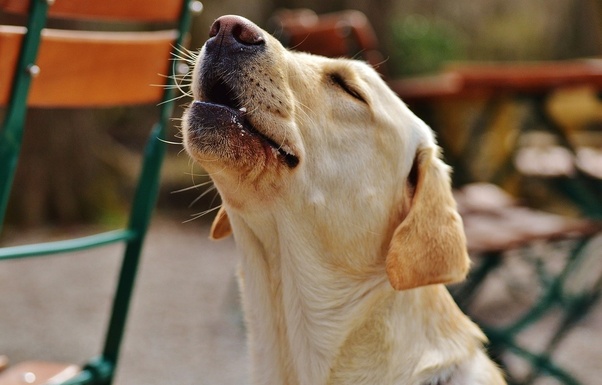The Harmonious Connection: Understanding Why Your Dog Howls When You Howl

Dogs have always been fascinating companions, with their unique behaviors and uncanny ability to connect with their human counterparts. One intriguing behavior that many dog owners have experienced is the phenomenon of their furry friend howling in response to their own howls. This peculiar interaction raises questions about the deep bond between humans and dogs and the ways in which our canine companions communicate. In this article, we delve into the reasons behind why your dog might howl when you do and explore the fascinating world of canine communication.
The Evolutionary Echo:
To comprehend this seemingly melodious exchange between human and canine, we must first look into the evolutionary roots of dogs. Domesticated from wolves thousands of years ago, dogs share common ancestry with their wild counterparts. Wolves, known for their vocalizations, use howling as a means of communication within their pack. This primitive form of communication allowed them to convey information about their location, warn of danger, or coordinate activities.
While domestication has transformed dogs into the lovable companions we know today, their ancestral instincts and behaviors are still deeply ingrained. Howling, being a social behavior, can be seen as a form of bonding, echoing the ancient roots of their wild ancestors. When your dog howls in response to your own howls, it could be their way of participating in a shared vocalization, creating a sense of unity and togetherness.
Imitating the Pack Leader:
Dogs are pack animals with a hierarchical structure, and they instinctively follow the lead of their pack leader. In a household setting, you assume the role of the pack leader, and your dog looks to you for guidance and cues on how to behave. When you howl, your dog may interpret it as a form of communication or an expression of emotion. In response, they may join in, mirroring your behavior as a way of reinforcing the bond between you and asserting their place in the pack.
This imitation behavior is not limited to howling; dogs often mimic other actions or sounds they observe in their human companions. It’s their way of participating in shared activities and expressing a desire for inclusion within the pack. So, when you find your dog howling alongside your own vocalizations, it’s likely their way of connecting with you and aligning themselves with the pack dynamics.
Expressing Emotion and Communication:
Dogs are highly sensitive to human emotions, and they often respond to our moods and expressions. When you howl, especially if it’s accompanied by laughter or excitement, your dog may interpret it as a positive and engaging activity. Dogs are social animals that thrive on interaction and communication, and by joining in the howling, they express their enthusiasm and eagerness to be a part of the shared experience.
Additionally, howling can be a way for your dog to communicate their own emotions or needs. If your dog is feeling lonely, anxious, or simply seeking attention, they may use howling as a form of vocalization to express themselves. By responding in kind, you acknowledge their communication and strengthen the emotional connection between you and your furry friend.
The Call of the Wild:
In certain situations, your dog’s howling may be triggered by external stimuli that evoke their primal instincts. Sirens, musical instruments, or even other dogs howling in the distance can act as stimuli that prompt your dog to join in the chorus. This behavior is reminiscent of the way wolves communicate across vast distances in the wild.
Your dog’s howling in response to external sounds can be seen as a natural response to the call of the wild, a deep-seated instinct that connects them to their ancestral roots. While it may seem like a mysterious or even amusing behavior, it highlights the adaptive nature of dogs and their ability to respond to a variety of environmental cues.
Addressing Excessive Howling:
While occasional howling can be a charming and endearing aspect of your dog’s behavior, excessive or prolonged howling may indicate underlying issues that need attention. Dogs may howl excessively due to anxiety, loneliness, or even physical discomfort. It’s crucial to observe your dog’s overall behavior, monitor any changes, and consult with a veterinarian if necessary.
Creating a harmonious environment, providing mental and physical stimulation, and ensuring your dog feels secure and loved are essential in addressing excessive howling. Understanding the reasons behind your dog’s vocalizations allows you to better meet their needs and strengthen the bond you share.
Conclusion:
The symphony of howls between you and your dog is a testament to the deep and ancient connection that exists between humans and their canine companions. Whether it’s an echo of their wild ancestry, an expression of shared emotions, or a response to external stimuli, the act of howling together reinforces the unique bond you share with your furry friend.
Embrace this harmonious exchange as a celebration of the rich tapestry of communication that exists between humans and dogs. As you howl together, you partake in a shared language that transcends words, forging a connection that spans generations and speaks to the enduring companionship between humans and their loyal canine counterparts.
Why does my dog howl when I howl?
A1: Dogs may howl when you howl for various reasons. One explanation is their instinctive connection to their wolf ancestors, who used howling for communication. Additionally, your dog may see it as a form of bonding, imitation of the pack leader, or an expression of emotion and excitement. Howling together can strengthen the bond between you and your furry friend.
Is it normal for dogs to mimic human behavior, like howling?
A2: Yes, it’s quite normal for dogs to mimic human behavior. Dogs are social animals that often imitate actions, sounds, or expressions of their human companions. When your dog howls in response to your howls, it’s a way for them to engage in shared activities, express their desire for inclusion, and reinforce the pack dynamics within a household setting.
What if my dog only howls in response to specific sounds or situations?
A3: Dogs may howl in response to external stimuli, such as sirens, musical instruments, or other dogs howling in the distance. This behavior is linked to their primal instincts and the way wolves communicate in the wild. If your dog exhibits selective howling, it’s likely a response to specific triggers that evoke their natural instincts and should be considered a normal part of their behavior.
How can I tell if my dog is howling due to emotional distress?
A4: While occasional howling is generally normal, excessive or prolonged howling could indicate emotional distress, anxiety, loneliness, or discomfort. To assess your dog’s well-being, observe their overall behavior, look for any changes, and consider environmental factors. If you’re concerned about your dog’s howling, consult with a veterinarian to rule out any underlying health issues and to receive guidance on addressing potential emotional concerns.
Can excessive howling be a sign of a behavioral problem?
A5: Excessive howling can sometimes be associated with behavioral issues, particularly if it is persistent and disruptive. Factors such as separation anxiety, boredom, or a lack of mental and physical stimulation may contribute to problematic howling. Addressing the root cause of the behavior, providing proper training, and ensuring a stimulating environment can help alleviate excessive howling.
How can I encourage or discourage my dog from howling?
A6: If you enjoy your dog’s howling and see it as a positive form of communication, you can reinforce the behavior by responding positively, perhaps with attention, play, or treats. However, if you want to discourage excessive howling, identify and address the underlying cause, provide ample mental and physical stimulation, and consider professional training or behavioral interventions.
Are certain dog breeds more prone to howling?
A7: While individual variations exist, some dog breeds are known to be more vocal than others. Breeds such as Huskies, Beagles, and Coonhounds, for example, are known for their propensity to howl. It’s essential to understand and appreciate the unique characteristics of your dog’s breed while also recognizing that training and environmental factors play significant roles in shaping their behavior.
Can howling be a sign of a medical issue?
A8: In some cases, excessive howling may be a sign of an underlying medical issue, especially if it is a sudden or significant change in behavior. Pain, discomfort, or other health issues could be contributing factors. If you’re concerned about your dog’s howling and suspect a medical problem, consult with a veterinarian for a thorough examination and appropriate diagnostic tests.
Can I use training methods to control my dog’s howling?
A9: Yes, training methods can be effective in controlling and modifying your dog’s behavior, including howling. Positive reinforcement, consistent commands, and rewarding desired behavior while ignoring or redirecting unwanted behavior can be part of a successful training approach. Consulting with a professional dog trainer may also provide valuable insights tailored to your specific situation.
Is there a way to differentiate between happy howling and distressed howling?
A10: Happy howling is often accompanied by positive body language, such as wagging tails, relaxed posture, and an overall excited demeanor. Distressed howling, on the other hand, may be accompanied by signs of anxiety, fear, or discomfort, such as pacing, excessive panting, or avoidance behavior. Understanding your dog’s overall behavior and context can help you differentiate between different types of howling and address their needs accordingly.






